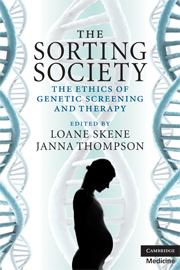Book contents
- Frontmatter
- Contents
- List of contributors
- Preface
- 1 Introduction
- 2 Genetic testing, an informed choice
- 3 Sex selection: sorting sperm as a gateway to the sorting society?
- 4 Cloning to avoid genetic disease
- 5 Procreative Beneficence: reasons to not have disabled children
- 6 Reprogenetic technologies: balancing parental procreative autonomy and social equity and justice
- 7 Genetic technology and intergenerational justice
- 8 Genetic preselection and the moral equality of individuals
- 9 Genes, identity and the ‘expressivist critique’
- 10 Overstating the biological: geneticism and essentialism in social cloning and social sex selection
- 11 The sorting society: a legal perspective
- Index
4 - Cloning to avoid genetic disease
Published online by Cambridge University Press: 16 September 2009
- Frontmatter
- Contents
- List of contributors
- Preface
- 1 Introduction
- 2 Genetic testing, an informed choice
- 3 Sex selection: sorting sperm as a gateway to the sorting society?
- 4 Cloning to avoid genetic disease
- 5 Procreative Beneficence: reasons to not have disabled children
- 6 Reprogenetic technologies: balancing parental procreative autonomy and social equity and justice
- 7 Genetic technology and intergenerational justice
- 8 Genetic preselection and the moral equality of individuals
- 9 Genes, identity and the ‘expressivist critique’
- 10 Overstating the biological: geneticism and essentialism in social cloning and social sex selection
- 11 The sorting society: a legal perspective
- Index
Summary
The use of prenatal diagnosis (PND) and pre-implantation genetic diagnosis (PGD) is familiar as methods that a couple might use to avoid the birth of a child with a genetic condition. However, these methods will not deal with all instances of genetic disease. Both work on the basis that only some of the embryos formed from the gametes of the couple will have the genetic condition. In PND, the idea is that an affected pregnancy can be terminated, so that the couple can try again, in the hope that the next pregnancy will not be affected. In PGD, the idea is that some embryos will not be affected, and they will be chosen for transfer, while the affected ones will be discarded. But there are a small number of situations where this process will not work. These are situations in which, because of the precise nature of the genetic mutation involved, all embryos created from the gametes of the couple will inevitably have the genetic condition which the couple wish to avoid in their children.
One possible way to get around this problem would be to use reproductive cloning to create an embryo solely from the genome of the unaffected partner, thus producing an unaffected child. The advantage of this approach over the alternative approach of using donor gametes is that a third party is not introduced into the equation. The resulting child would be genetically related to the one parent, and to no-one else.
- Type
- Chapter
- Information
- The Sorting SocietyThe Ethics of Genetic Screening and Therapy, pp. 37 - 50Publisher: Cambridge University PressPrint publication year: 2008



